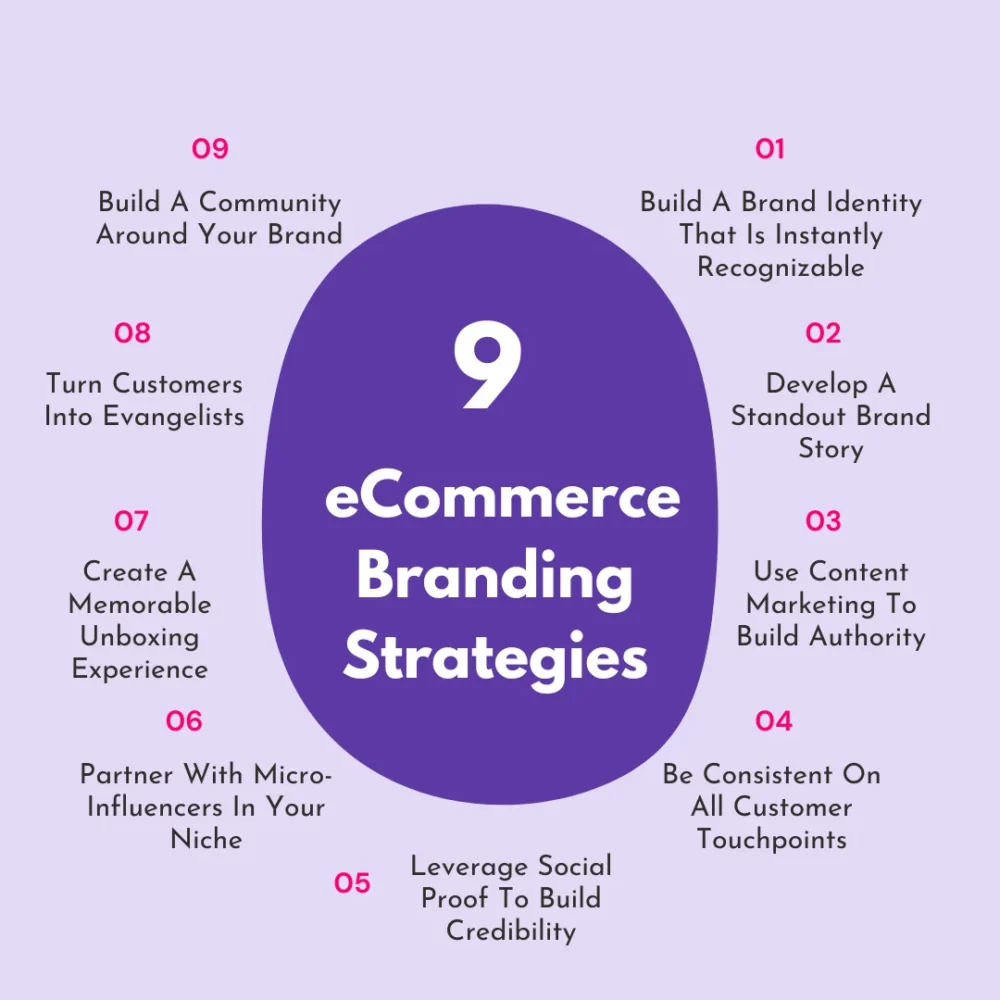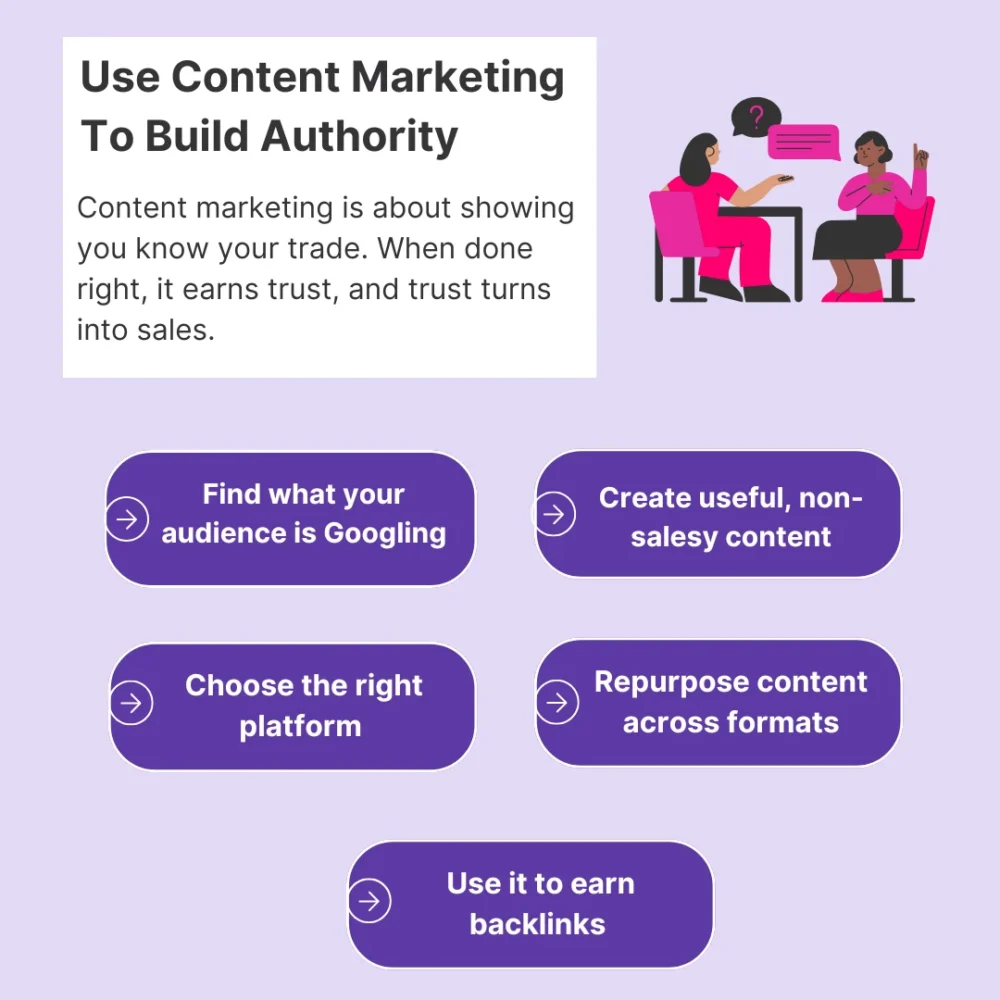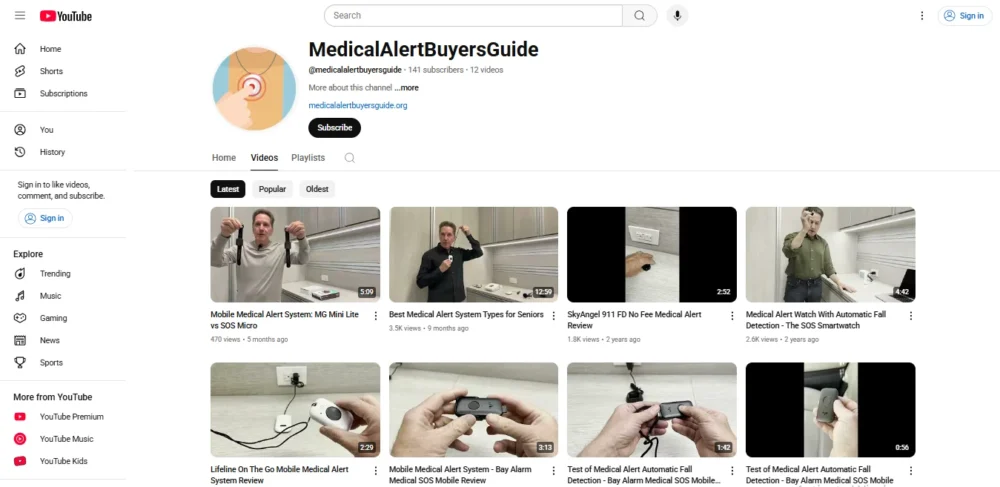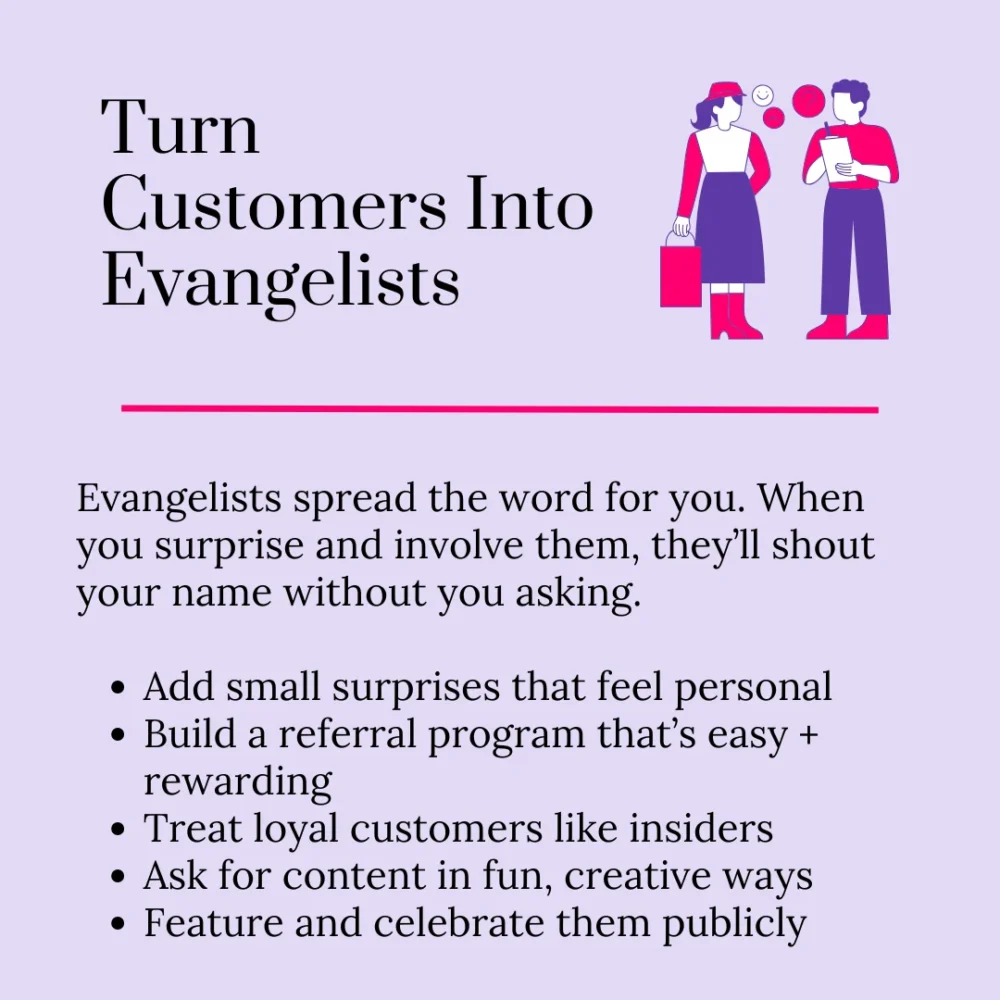In this article:
Everyone is selling something. And most of it looks like a copy of a copy. Same feel. Same fake urgency. Same forgettable everything. When you have maybe two seconds to hit a nerve, you need a solid eCommerce branding strategy that makes a half-asleep shopper at 2 a.m. trust you enough to buy without a second thought.
But the problem is that most people don’t actually know which strategies to use, let alone how to use them. That’s why this guide exists – to break down 9 eCommerce branding strategies that make people pause and remember your brand long after they have closed the tab.
9 eCommerce Branding Strategies To Help You Stand Out In A Crowded Market

If you want people to care – really care – here are 9 eCommerce branding strategies that will make them feel something the second they land on your page.
1. Build A Brand Identity That Is Instantly Recognizable
People don’t remember average. They remember different. And if your store feels like every other Shopify template with a logo swap, you are giving them nothing to hold onto.
Let’s start here:
Your brand identity is more than just your logo or color scheme. It is the feel people get the second they land on your site. It is what they associate with your product and how you show up visually across everything – your packaging, social posts, website, emails, and even customer service DMs.

Get 300+ Fonts for FREE
Enter your email to download our 100% free "Font Lover's Bundle". For commercial & personal use. No royalties. No fees. No attribution. 100% free to use anywhere.
What To Do
Step 1: Lock in your brand basics
Pick:
- 1 primary color (the one you use everywhere)
- 1 or 2 accent colors
- 1 clean font for headings + 1 readable font for body text
- A logo that works well everywhere (desktop, mobile, packaging, favicon, etc.)
Step 2: Choose a personality
Are you bold and witty? Soft and nurturing? Straight-talking and no-BS? Define it. Then stick to it in every post, every email, every product description for better brand recognition.
Step 3: Keep your visuals consistent
That means using your color palette in all product shots, banners, and even IG stories. If your site looks one way and your social media another, people get confused. And confusion kills sales.
Step 4: Create a brand style guide.
Don’t overthink it – even a simple Google Doc works. Include logo usage rules, color codes, tone of voice examples, and do’s/don’ts for visuals. Share this with your team (or just yourself, if you are solo).
Step 5: Hire a brand identity designer
There is a point where DIY branding starts costing you more than it saves. If your visuals feel all over the place or you are spending hours tweaking Canva templates that still look off, it is time to hire a brand identity designer. They will extract the essence of your brand and transform it into visuals that actually mean something to your audience.
2. Develop A Standout Brand Story
Your story is what makes your brand different, especially if your products aren’t that unique. There are probably 100 other eCommerce businesses selling what you sell. But your brand’s story? That’s yours. And when people connect with it, they trust you more. They buy from you more. They talk about you more.
What To Do
Step 1: Answer these questions (honestly):
- Why did you start this brand? (Was there a personal struggle or frustration?)
- Who are you really building this for?
- What do you believe in that others don’t talk about?
Step 2: Tie your story into your customer’s journey
It is not just about you. It is about how your story connects to them. If you created a skincare line because nothing worked for your sensitive skin, that is relatable. People struggling with the same problem will care.
Step 3: Keep it tight and authentic
Don’t write a novel. Write 3-5 sentences that could fit on your About page, in an email, or even in a caption.
Step 4: Use it everywhere
Weave your story into:
- Your homepage
- Your product descriptions
- Your packaging
- Your email welcome sequence
- Your ads
3. Use Content Marketing To Build Authority

Let’s say someone just discovered your eCommerce store. They like what they see, but they are still unsure. Now what?
Well, you need content marketing to educate them and guide them until they are ready to buy. Content builds trust. People see you as the expert. And in a crowded market, trust is what drives the sale, not just discounts or pretty photos.
What To Do
Step 1: Know what your customers are Googling
What problems are they trying to solve? What are they confused about? What are they trying to learn? Use tools like:
- Google’s “People also ask”
- Reddit threads
- AnswerThePublic
- Customer support queries
Step 2: Create helpful, non-salesy content
Write or record content that actually helps. Think:
- How-to guides
- Product comparisons
- Styling tips
- Ingredient breakdowns
- FAQs in video format
- Tutorials or quick wins
Step 3: Choose your format + platform
You don’t need a blog and a YouTube channel and a podcast. Pick what suits your product and target audience.
For example:
- Skincare or fashion? Instagram Reels or TikTok.
- Fitness gear or wellness supplements? YouTube or blog articles.
- High-consideration products (tech, furniture)? In-depth blog content or case studies.
Step 4: Optimize and repurpose
Take a blog post → break it into 3 Instagram posts → turn it into a Pinterest infographic → film a short Reel about it.
Keep spreading the same message in different formats to reach people where they are.
Step 5: Use content to build links
Link building turns the slow burn into serious traffic. When you create valuable, original content, other blogs and creators start linking to it. It is a credibility signal for Google and a major boost for your search rankings.
4. Be Consistent On All Customer Touchpoints
You can have the coolest branding in the world, but if your email feels like it was written by someone else or your ads look off-brand, people get confused. And confused people bounce.
Consistency isn’t about being boring. It is about making sure every part of your brand wears the same clothes and shows up the same way. This builds familiarity. Familiarity leads to trust. And trust leads to customer loyalty.
What To Do
Step 1: Map out your touchpoints
Make a quick list of everywhere your brand “talks” to the customer. That usually includes:
- Website (product pages, checkout, thank-you page)
- Social media platforms (captions, replies, bios)
- Emails (newsletters, receipts, abandoned cart)
- SMS or WhatsApp messages
- Packaging slips, unboxing, and follow-ups
- Customer service responses
Step 2: Standardize your tone and voice
If you are casual and cheeky on Instagram, don’t sound robotic in your order confirmation emails. Decide how you speak, then apply it everywhere. Even on your returns page. This consistency matters whether you’re selling skincare, stationery, or wedding rings for women.
Pro tip: Write up a “brand voice cheat sheet” with sample phrases, emojis, and writing rules. Use that across your team (or just to keep yourself consistent).
Step 3: Keep visuals aligned
Same filters, same fonts, same design feel. If you are soft and neutral, don’t go neon in your ads. If you are bold and loud, don’t show up with muted pastels on your packaging.
Step 4: Automate without sounding like a bot
Templates are great, but always tweak them to sound human and on-brand. Your post-purchase thank-you email should feel like you wrote it, not a stock template.
Let’s talk about a brand that’s doing this whole “consistent across every touchpoint” thing perfectly – MedicalAlertBuyersGuide. In the medical alert space, trust is everything. People are literally relying on brands for their safety, so mixed messaging or hidden surprises just won’t fly.
They are talking to seniors and caregivers, people who are making decisions about life-saving devices. These aren’t impulse buys. So, MedicalAlertBuyersGuide keeps things simple by focusing on Facebook and YouTube. That chosen minimalism makes each touch feel intentional – nothing is half-baked.
Their Facebook posts don’t try to be trendy or salesy. They are calm. Helpful. Easy to understand. You will see things like “Here’s how to get a discount through AARP” or “Watch out for these hidden fees when choosing a medical alert system.” It is the same tone every time – reassuring, knowledgeable, never pushy.

Then you go over to their YouTube channel, and it is like walking into the same room. The colors match. The language matches. The feel matches. Their videos are titled clearly (“Best Medical Alert Systems for 2025,” “How Fall Detection Really Works”), and the delivery feels just like their posts: patient, informative, and human.
This is how you build loyalty without ever having to say, “Trust us.” You just show up the same way, everywhere, every time.
5. Leverage Social Proof To Build Credibility
Most people don’t believe your eCommerce business until they see that other people already do. That is why social proof matters. Especially in a crowded market where new eCommerce stores are popping up every day, your audience needs to see that you are not just saying you are legit, you actually are.
Social proof \= other people talking about you. It can come in many forms, and it is what pushes people off the fence and into buying
What To Do
Step 1: Collect reviews like it is your job
Don’t just wait for people to leave reviews – ask. Follow up with customers via email a few days after delivery. Make it easy. Add incentives (like 10% off their next order). Use a tool like Loox or Okendo to automate this.
Step 2: Highlight UGC (user-generated content)
User-generated content includes:
- Customer unboxing videos
- Styling or usage photos
- TikToks with your product in action
- Before-and-after shots
Repost that stuff. Feature it on your product pages and pin it on Instagram. Make your happy customers part of your brand.
Step 3: Show off numbers and milestones
- “Over 50,000 sold.”
- “4.9 stars from 2,100+ reviews.”
- “Chosen by 8 out of 10 beauty editors.”
You don’t have to be a massive brand – even “100 happy customers this month” builds trust.
Step 4: Add credibility cues in strategic places
- Put top reviews on your homepage
- Add UGC under product listings
- Share real testimonials in ads
- Include customer quotes in your email headers
Step 5: Bring in a social media manager
Social proof doesn’t work if no one sees it. If your feed is collecting dust and UGC goes unused, it is not a proof problem; it is a distribution problem – something that an expert social media manager can solve. They know how to turn customer content into momentum. They will spot what is worth sharing, package it right, and post it where your audience is.
One online store that got this strategy right is Golf Cart Tire Supply. They ditch the fake and focus on the real. They share behind-the-scenes glimpses of their warehouse and add explanatory videos of how different features and products work.

The company uses its Instagram to create content that entertains and engages. Funny videos showing epic golf cart fails and heartwarming customer stories. It is all there. They turn everyday people into stars by featuring photos and videos they send in. This has allowed Golf Cart Tire Supply to build a community that goes beyond transactions.
6. Partner With Micro-Influencers In Your Niche
You don’t need to hire a Kardashian to make your brand feel influential. Micro-influencers (people with 2,000 to 50,000 followers) can give you better engagement and way more targeted reach, especially if they are tightly aligned with your niche.
They are everyday creators with loyal audiences who listen to them. And when they talk about your product like a genuine fan, people pay attention.
What To Do
Step 1: Find influencers who already align with your brand
Don’t just look for people with big followings. Look for:
- High engagement (check their likes/comments ratio)
- Real connection with their audience (read the comments)
- A natural aesthetic or tone that matches your brand vibe
Pro tip: Use tools like Collabstr or just deep-search on TikTok/Instagram using niche hashtags.
Step 2: Reach out personally
Skip the generic “Hey, we love your content!” DMs. Be specific. Mention a post of theirs you liked and offer them a free product or a small paid collab. Keep it conversational – not corporate.
Step 3: Let them create in their own voice
You are working with them because their audience trusts them. Don’t hand them a stiff script. Give them your brand context and a few talking points – then let them do their thing.
Step 4: Build long-term relationships
One-off shoutouts can work, but ongoing partnerships are better. They feel more authentic and give their audience more chances to remember your brand.
Step 5: Track ROI smartly
Use discount codes, affiliate links, or trackable landing pages to see who is driving real traffic and conversions. Double down on what works.
If you want to see a brand doing exactly what we are talking about without loud, overproduced ads, look at Transparent Labs. They are a fitness supplement brand, and they have built serious credibility by building a system around the micro-influencers on Instagram and TikTok.
Their TL Partner program is a goldmine if you are studying how to structure micro-influencer partnerships right. It is not some one-time “get a free tub of pre-workout and post a pic” type of thing.
It is an actual tiered program that lets smaller creators become long-term brand collaborators. Influencers get early product access, exclusive discounts for their audience, and commission for every sale they drive.
And the results? Scroll through #TransparentLabs or their tagged posts, and you will see high-trust fitness influencers with 5k, 10k, 20k followers casually recommending products like PreSeries BULK or their Magnesium Bisglycinate.
So yes, Transparent Labs isn’t paying $100K for one shoutout. They are building hundreds of mini trust loops, and that is the stuff real brands are made of.
7. Create A Memorable Unboxing Experience
You know that little burst of excitement when a package arrives at your door? That is your moment. That is the only physical interaction an eCommerce brand gets to have with its customers. And if you make it unforgettable, you instantly elevate your brand.
People don’t remember “okay” packaging. They remember experiences. And when it is good enough, they will post it and talk about it.
What To Do
Step 1: Upgrade your packaging (without overcomplicating it)
You don’t need to go full luxury – just make the packaging thoughtful. That might look like:
- A branded box with your logo or signature color
- Custom tissue paper or inserts
- A personal thank-you card or message
- Stickers, samples, or a small freebie
Step 2: Brand the experience, not just the product
How it feels to open your box should reflect your brand’s personality. If you are playful, maybe you can add a quirky message inside the flap. If you are high-end, make the textures and colors feel premium.
Step 3: Use this as a chance to reinforce value
Add a QR code linking to a welcome video or styling tips. This turns your packaging into a functional brand touchpoint.
Step 4: Make it share-worthy
Yes, aesthetics matter. But it is not just about being “pretty.” It is about sparking joy. Make them say “Wait, this is cool – I need to post this.”
Bonus Tip: Encourage unboxing posts by including a note like “Tag us @yourbrand for a chance to be featured.” People love being seen. And their content becomes your social proof.
8. Turn Customers Into Evangelists

Happy customers are great. Evangelists are gold. These are the people who love your brand so much, they tell everyone about it – unprompted, unpaid, just because they believe in it. And every time they rave about you, your customer acquisition costs drop.
Evangelists don’t appear out of nowhere. They are created through consistency and a little bit of delight. Invest in them, and their brand loyalty will do more for your brand than any paid ad.
What To Do
Step 1: Deliver something unexpectedly good
To get someone talking about you, you have to do something worth talking about. That could be:
- A personal thank-you video from the founder
- Following up post-purchase to check how things are going
- Surprise upgrades or bonuses in their second order
Step 2: Create a referral program that feels rewarding
Make it easy for customers to share your brand. And reward them for it. The simpler and faster the reward, the better. Don’t make people jump through hoops. Think:
- Store credit for referrals
- Early access to product drops
- Exclusive perks just for referring a friend
Step 3: Engage customers like they are part of your inner circle
Reply to their stories. Feature them in your feed. Invite them to beta tests. Give them sneak peeks or behind-the-scenes updates.
Step 4: Ask for content and make it fun
Instead of just saying “leave a review,” try:
- “Tell us your glow-up story using [your product].”
- “Show us how you styled it!”
- “What’s the weirdest/funniest place you’ve used [product name]?”
9. Build A Community Around Your Brand
Brands sell products. But communities sell belonging. And if you can make your customers feel like they are part of something bigger than just a transaction, you’ve got a brand that lasts. That is because a strong community gives you something no competitor can copy: connection.
What To Do
Step 1: Choose your platform
Where do your customers already spend time? That is where your community should live. Don’t try to be everywhere. Pick one channel and own it.
- Skincare or beauty brand? Instagram or a private Facebook group.
- Fitness or wellness? Discord or a private Slack.
- High-ticket or niche items? Email-based community or a gated forum.
Step 2: Create a purpose beyond selling
Your community shouldn’t just be a glorified product feed. Build it around a shared interest, challenge, or identity. For example:
- “Clean Beauty 101” – share skincare routines and debunk myths.
- “Small Space Decor Tribe” – for renters using your home accessories.
- “Plant Parents Club” – weekly care tips, rescue stories, and growth hacks.
Step 3: Start conversations
People won’t talk unless you give them a reason. Try:
- Weekly prompts (“What’s your latest product obsession?”)
- Member shoutouts
- Live Q\&As about product quality
- Behind-the-scenes content
- Polls or mini contests
Step 4: Spotlight your community
Show them off. Use their photos, quote their reviews, tell their stories. The more your community feels seen, the more active they will be.
Step 5: Let your brand step back sometimes
The best communities are self-sustaining. Let members talk to each other. Encourage peer-to-peer advice and sharing. That is when you know it is real.
Why Most eCommerce Branding Strategies Fail: 5 Costly Mistakes & How To Fix Them

Let’s walk through the 5 most common (and costly) branding mistakes eCommerce brands make — and exactly how to fix them before they burn a hole in your brand’s reputation.
1. Mistaking Product Features For A Brand Message
Product details don’t differentiate you. Features describe what the product is, not why someone should care. If you are only marketing features, you are blending in with every other store that sells a similar thing.
How To Fix It:
- Translate features into emotional benefits.
- Ask yourself, “So what?” Keep going until you get to the emotional core.
- Use your message everywhere. It is what you lead with, not bury at the bottom.
2. Treating Branding As A One-Time Setup
Many brands launch with a fancy logo and a handful of designed templates — and then… never touch it again. Branding is not a mood board. It is a living, breathing system that evolves as your audience and target market shift.
How To Fix It:
- Revisit your brand quarterly and schedule a 1-hour review.
- Watch how customers talk about you. Your real brand lives in your customers’ conversations, not your brand guidelines.
- Update small things regularly. Tweaking your tone or adjusting your product names can make a huge difference.
3. Designing For Trends, Not Longevity
It is tempting to follow whatever is hot right now – muted beiges, retro fonts, grainy product shots. But building your brand values around what is trending instead of what is true to you is a fast path to forgettable.
How To Fix It:
- Define your visual foundation before chasing trends.
- You can borrow a trend, like rounded corners or Gen Z slang, but don’t rebuild your entire brand around it.
- Audit your visuals every 6 months. Ask yourself: Is this still us, or are we just mimicking what we are seeing in our feed?
4. Not Understanding Your Real Buyer
A lot of brands build everything for the ideal customer they want, not the actual person who is buying. There is a big difference.
If your branding is aimed at a 25-year-old wellness junkie but your real buyers are 40-year-old moms with busy lives, there is going to be a disconnect. And that disconnect will quietly tank your conversions.
How To Fix It:
- Dive into your order data. Look at who is buying the most often and what locations or demographics keep showing up.
- Send a quick survey to new and repeat customers. You don’t need a giant research team – just 10 honest responses can reshape how you talk.
- Adjust your branding to meet them. Your ideal customer is the person who is already buying from you.
5. Ignoring The Post-Purchase Journey
Too many eCommerce brands go hard on first impressions and completely fall off the map after the sale. Your branding matters more once money is exchanged. If your branding efforts only show up during the sale, you become forgettable fast.
How To Fix It:
- Brand your post-purchase emails. Add personality to subject lines and use language that reflects your tone
- Create an onboarding sequence.
- Keep nurturing without selling. Send content-driven emails that deliver value, not just discounts.
Conclusion
Branding in eCommerce nowadays is less “polish your logo” and more “create a personality your customers want in their life.” And the eCommerce branding strategies you just read are meant to shake things up. So, forget playing it safe. Safe brands sink. Bold ones get screenshotted and talked about in chats. Nail one strategy from the list, then layer on the next.
If you are serious about making your brand feel like something, start surrounding yourself with inspiration that actually pushes you forward. And we at DesignWorkLife can help you with that. It is where creative direction meets real-world execution – from design ideas that don’t feel recycled to branding insights that go way deeper than surface-level trends.
Scroll it, bookmark it, steal from it (we won’t tell). Just make sure you are creating an experience that feels as fresh as the successful eCommerce brands featured there.

